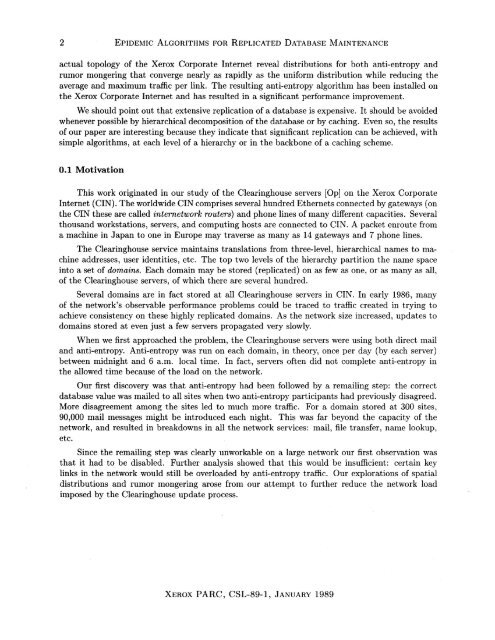CSL-89-1_Epidemic_Algorithms_for_Replicated_Database_Maintenance
CSL-89-1_Epidemic_Algorithms_for_Replicated_Database_Maintenance
CSL-89-1_Epidemic_Algorithms_for_Replicated_Database_Maintenance
You also want an ePaper? Increase the reach of your titles
YUMPU automatically turns print PDFs into web optimized ePapers that Google loves.
2 EPIDEMIC ALGORITHMS FOR REPLICATED DATABASE MAINTENANCEactual topology of the Xerox Corporate Internet reveal distributions <strong>for</strong> both anti-entropy andrumor mongering that converge nearly as rapidly as the uni<strong>for</strong>nl distribution while reducing theaverage and maximum traffic per link. The resulting anti-entropy algorithnl has been installed onthe Xerox Corporate Internet and has resulted in a significant per<strong>for</strong>nlance inlprovenlent.We should point out that extensive replication of a database is expensive. It should be avoidedwhenever possible by hierarchical decomposition of the database or by caching. Even so, the resultsof our paper are interesting because they indicate that significant replication can be achieved, withsimple algorithms, at each level of a hierarchy or in the backbone of a caching schenle.0.1 MotivationThis work originated in our study of the Clearinghouse servers [Op] on the Xerox CorporateInternet (CIN). The worldwide CIN comprises several hundred Ethernets connected by gateways (onthe CIN these are called internetwork routers) and phone lines of many different capacities. Severalthousand workstations, servers, and computing hosts are connected to CIN. A packet enroute froma machine in Japan to one in Europe may traverse as many as 14 gateways and 7 phone lines.The Clearinghouse service maintains translations from three-level, hierarchical names to machineaddresses, user identities, etc. The top two levels of the hierarchy partition the name spaceinto a set of domains. Each domain may be stored (replicated) on as few as one, or as many as all,of the Clearinghouse servers, of which there are several hundred.Several domains are in fact stored at all Clearinghouse servers in CIN. In early 1986, manyof the network's observable per<strong>for</strong>mance problems could be traced to traffic created in trying toachieve consistency on these highly replicated domains. As the network size increased, updates todomains stored at even just a few servers propagated very slowly.When we first approached the problem, the Clearinghouse servers were using both direct mailand anti-entropy. Anti-entropy was run on each domain, in theory, once per day (by each server)between midnight and 6 a.m. local time. In fact, servers often did not complete anti-entropy inthe allowed time because of the load on the network.Our first discovery was that anti-entropy had been followed by a remailing step: the correctdatabase value was mailed to all sites when two anti-entropy participants had previously disagreed.More disagreement among the sites led to much more traffic. For a domain stored at 300 sites,90,000 mail messages might be introduced each night. This was far beyond the capacity of thenetwork, and resulted in breakdowns in all the network services: mail, file transfer, name lookup,etc.Since the rem ailing step was clearly unworkable on a large network our first observation wasthat it had to be disabled. Further analysis showed that this would be insufficient: certain keylinks in the network would still be overloaded by anti-entropy traffic. Our explorations of spatialdistributions and rumor mongering arose from our attempt to further reduce the network loadimposed by the Clearinghouse update process.XEROX PARC, <strong>CSL</strong>-<strong>89</strong>-1, JANUARY 19<strong>89</strong>



